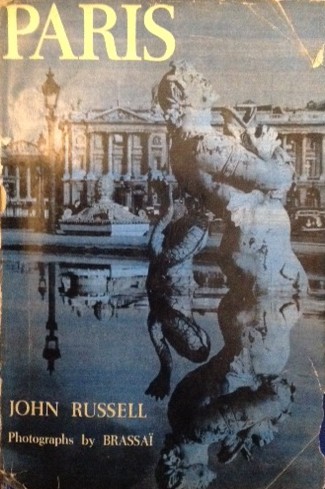Inspiring Older Readers
 posted on 25 Apr 2018
posted on 25 Apr 2018
Paris by John Russell with photographs by Brassai
This 1960 history-cum-appreciation of the city of Paris caught my attention because it is liberally illustrated with black and white photographs by the very wonderful Brassai. This was the working name of the Hungarian, Gyula Halász who was born in 1899 and died in 1984, moving to live in Paris when he was in his early 20s. His fame is largely associated with his documenting of the streets and night-life of Paris which he sold to magazines to earn his living.
During his early years in Paris he developed a friendship with the writer, Henry Miller who introduced him to the network of artists living in the city in the inter-war years. Brassai, always alert to the main chance, used this connection to build a substantial portfolio of photographic portraits that included Dali, Matisse and Picasso.
He went on to work for Harpers Bazaar and became a founding member of the Rapho photographic agency which helped bring him wider international acclaim. After the Second World War, Brassai became something of a favoured celebrity in New York and one man exhibitions followed.
It’s fair to say, however, that despite his international appeal, it’s his work on the streets and in the nightclubs of Paris that remain his most admired work – and this is certainly my favourite period of his career. So he must have seemed the most obvious choice to provide the photographs for John Russell’s book.
Although I paid up my few pounds for this book because of the Brassai photographs, it would be wrong to ignore John Russell’s text. Russell is an interesting character himself who died in 2008 at the age of 89 after spending the 1980s as the art critic of The New York Times. After leaving the Tate in 1940 where he had been an unpaid intern, he joined naval intelligence where he met Ian Fleming – and this contact was something of a turning point. Fleming used his influence to get Russell a reviewing job on The Sunday Times and this would be the opening that would eventually lead him to New York.
This book isn’t a big, sumptuous production and the photographic plates haven’t been printed to art book standard but perversely that’s all part of its appeal. This isn’t a coffee-table book produced for display but a much more utilitarian publication that’s designed to be read and even carried with you on your trip to Paris. It’s not in any way a guide book but you could certainly let yourself be guided by it. Russell unfolds the history of the city and it’s the kind of book that would allow you discover the nooks and crannies that tourist guide books will never tell you about. The people and politics of France may have changed since 1960 when the book was written but the historic buildings of Paris remain essentially the same as the author describes them.
I found the book in a junk shop and my copy has certainly seen better days – but then again it only cost me two quid to buy. If you are interested in getting your hands on a similar edition, the good news is that you won’t have to find a fortune to get one from an online second hand dealer – expect to pay about a tenner. The Brassai photographs alone are worth that.
Terry Potter
April 2018
( Click on any of the photographs below to see the images in slide show format )






